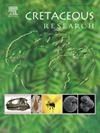来自巴塔哥尼亚的首个瓦朗基尼期(早白垩世)兽脚类恐龙(恐龙亚目,鸟脚亚目
IF 1.9
3区 地球科学
Q1 GEOLOGY
引用次数: 0
摘要
在这里,我们描述了巴塔哥尼亚西北部瓦朗基尼岩(早白垩世)中的一个新的兽脚类物种--Emiliasaura alessandrii gen.这一新类群与Rhabdodontomorpha亲缘关系密切,主要由从Mulichinco地层的不同地点和地层中采集的两个中型兽脚类标本代表。主模式标本 MLL-Pv-001 包括冠状体、肩胛骨近端、肱骨和完整的右后肢,而副模式标本 MLL-Pv-006 则保留了脊椎元素、血弓、不完整的骨盆和几乎完整的后肢。新类群的髂骨前后缘较长,背缘呈弧形,后髂骨架较宽,股骨柄上有一个宽阔的、位于股骨柄中部的第四转子,第二蹬足指骨短而粗壮,无趾骨钝,与踝多足兽脚类的指骨相似。这一新的兽脚类恐龙类群是穆利钦科地层中多种恐龙类群的一部分,这些恐龙类群包括双龙类的蜥脚类恐龙和角龙类的兽脚类恐龙,是南美洲首次记录到的横纹龙类恐龙,也是这一类群中最古老、最原始的代表。本文章由计算机程序翻译,如有差异,请以英文原文为准。

First Valanginian (Early Cretaceous) ornithopod (Dinosauria, Ornithischia) from Patagonia
Here we describe a new ornithopod species, Emiliasaura alessandrii gen. et sp. nov. from Valanginian rocks (Early Cretaceous) of northwestern Patagonia. This new taxon exhibits affinities with the Rhabdodontomorpha and is primarily represented by two specimens of mid-sized ornithopods collected from different sites and stratigraphical levels of the Mulichinco Formation. The holotype specimen MLL-Pv-001 includes the coracoid, the proximal end of a scapula, a humerus and a complete right hind limb, whereas the paratype specimen MLL-Pv-006 preserves vertebral elements, haemal arches, an incomplete pelvis, and nearly complete hind limbs. The new taxon has an anteroposteriorly elongate ilium with a sigmoidal dorsal border and broad brevis shelf, a femur shaft with an extensive, mid-shaft positioned fourth trochanter, and a second pedal digit with a short, robust, blunt ungual phalanx similar to those in Ankylopollexia ornithopods. The new ornithopod taxon formed part of a diverse dinosaur association from the Mulichinco Fm that includes dicraeosaurid sauropods and carcharodontosaurid theropods, and represents the first South American record of a rhabdodontomorph, and the oldest and most primitive representative of this clade.
求助全文
通过发布文献求助,成功后即可免费获取论文全文。
去求助
来源期刊

Cretaceous Research
地学-地质学
CiteScore
4.10
自引率
19.00%
发文量
235
审稿时长
12 weeks
期刊介绍:
Cretaceous Research provides a forum for the rapid publication of research on all aspects of the Cretaceous Period, including its boundaries with the Jurassic and Palaeogene. Authoritative papers reporting detailed investigations of Cretaceous stratigraphy and palaeontology, studies of regional geology, and reviews of recently published books are complemented by short communications of significant new findings.
Papers submitted to Cretaceous Research should place the research in a broad context, with emphasis placed towards our better understanding of the Cretaceous, that are therefore of interest to the diverse, international readership of the journal. Full length papers that focus solely on a local theme or area will not be accepted for publication; authors of short communications are encouraged to discuss how their findings are of relevance to the Cretaceous on a broad scale.
Research Areas include:
• Regional geology
• Stratigraphy and palaeontology
• Palaeobiology
• Palaeobiogeography
• Palaeoceanography
• Palaeoclimatology
• Evolutionary Palaeoecology
• Geochronology
• Global events.
 求助内容:
求助内容: 应助结果提醒方式:
应助结果提醒方式:


